Affiliate links on Android Authority may earn us a commission. Learn more.
The best wireless earbuds for Android













With so many options, picking the best wireless earbuds can be tricky. From active noise canceling (ANC) and custom sound profiles to basics like your budget or platform of choice, there are many things to consider before you buy. We have reviewed the best wireless earbuds to help you find the perfect fit for your needs. Although we focus on the best earbuds for Android, we have not neglected iPhone owners.
To brush up on your earbud knowledge, jump down to the buyer’s guide below. Otherwise, let us introduce you to the Sony WF-1000XM5.
The Sony WF-1000XM5 are the best wireless earbuds for most people


The Sony WF-1000XM5 are a cut above the rest. These earbuds boast premium build quality and even more powerful ANC than the WF-1000XM4 before them. This, combined with the array of customization options, makes the WF-1000XM5 our pick for the best earbuds for Android.
Sony slimmed down the WF-1000XM5, making them 25% smaller and 20% lighter than their predecessors. Our sister site, SoundGuys, found the WF-1000XM5 notably more comfortable than the WF-1000XM4. Sony retained many of the things we loved about the WF-1000XM4. For example, the new flagship earbuds have the same IPX4 water-resistant build. That means you can exercise with them — just dry them off before putting them back in the case.
The WF-1000XM5 have excellent low-frequency noise cancelation. With ANC on, airplane engines will sound one-quarter to one-eighth as loud as they would without the buds. The WF-1000XM5 shine when it comes to blocking out high-frequency noises. These types of sounds are essentially muted. Wearing the WF-1000XM5 will make it nearly impossible to hear keyboard clicks and background chit-chat. We attribute this improved passive isolation to the memory foam ear tips. Listeners unsure which ear tips to pick can take a test in the free mobile app.
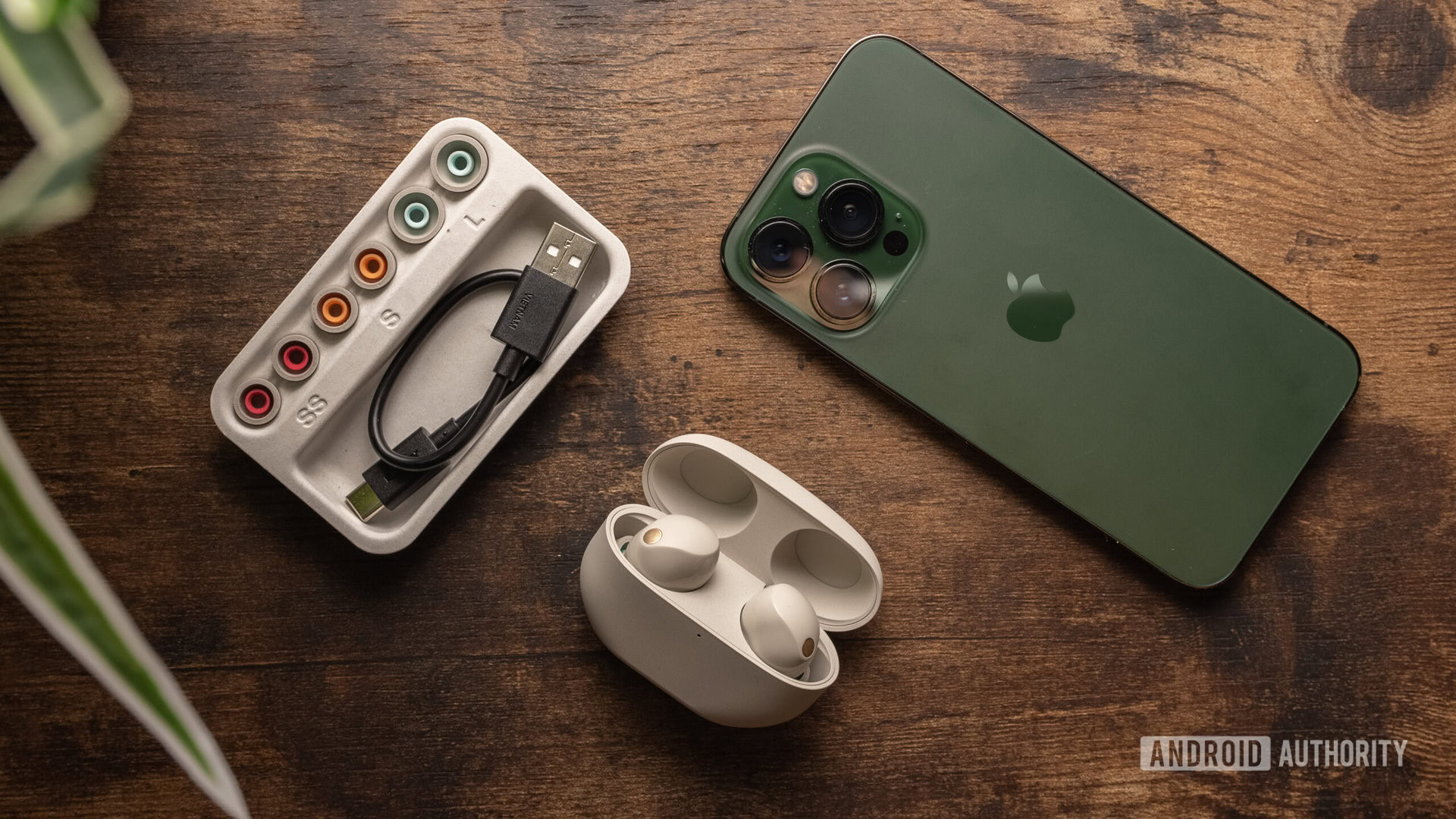
The Sony Headphones Connect app works with Android and iOS. The experience is universal across operating systems. With the app, you can enable audio passthrough to hear your environment with the music. Personalized Sony 360 Reality Audio is one of the most advanced features. This creates an optimized sound profile for the best spatial audio experience. Unlike the WF-1000XM4, the WF-1000XM5 support head tracking when streaming compatible content.
The app also offers a custom EQ module, EQ presets, and listening modes. Listeners can prioritize streaming quality or connection stability, which is useful if they notice playback hiccups while listening to music. Sony debuted these buds with multipoint connectivity, meaning they can run two active connections simultaneously. Like other flagship earbuds, the Google Find My Device app helps locate the WF-1000XM4.
The Sony WF-1000XM5 tick all the boxes no matter your use case.
We think most people will like the WF-1000XM5’s default sound, but some may find it a bit bass-heavy. If that is the case, play with Sony’s in-app equalizer. Decreasing the bass output by a few notches will make vocals and cymbal crashes stand out more.
Sony includes a host of Bluetooth codecs (SBC, AAC, and LDAC). The earbuds use Bluetooth 5.3 and work with LE Audio-compatible handsets. With noise canceling on, SoundGuys’ testing found the WF-1000XM5 last nine hours and 32 minutes. The case provides an extra 16 hours of playtime and can fast charge the buds. A three-minute charge will supply one hour of listening. Once the charging case needs a recharge, pop it on a Qi mat or plug it in with the USB-C cable.
The Sony WF-1000XM5 are the best noise canceling earbuds for most listeners. You get some of the best pocketable ANC money can buy. Not to mention plenty of customization options from the mobile app and a durable, handsome design. The impressive battery life makes these great earbuds for long flights. If you want earbuds that can do it all and make it easy, pick up the Sony WF-1000XM5. Otherwise, the older WF-1000XM4 will get you most of the way there for ($278 at Amazon.)
What makes them stand out
- Comfortable foam ear tips: The Sony WF-1000XM5 include four sizes of foam ear tips (XS-L) that block out distracting sounds.
- Great ANC: Sony’s noise canceling is some of the best around, and the memory foam ear tips protect you from distracting high-pitched sounds.
- IPX4 rating: You can take these buds to the gym without too many worries.
- Handy mobile app: The Sony Headphones Connect app makes it easy to tinker with the sound to suit your tastes.
- Good battery life: With nine hours and 32 minutes of charge, the Sony WF-1000XM5 can endure more than an entire workday.
Best of the rest: 7 other sets of wireless earbuds worth considering
For most people, we recommend the Sony WF-1000XM5. These earbuds host handy features, are easy to use, and work great with many devices. However, some models might suit you better. Here are some of our other picks:
- Samsung Galaxy Buds 2 Pro: These Bluetooth earbuds have excellent noise canceling and boast Samsung-exclusive features.
- Apple AirPods Pro (2nd generation): Due to their ANC, spatial audio, and excellent sound quality, these are the default do-it-all buds for iPhone owners.
- Google Pixel Buds Pro: Google’s noise canceling earbuds are comfortable, and the company has already added features like spatial audio with head tracking.
- Jabra Elite 8 Active: Jabra’s latest durable IP68-rated buds bring improved battery life and sound quality, making these workout earbuds an excellent choice for indoor and outdoor use.
- Bose QuietComfort Ultra Earbuds: These well-fitting earbuds boast impressive noise canceling and the aptX Adaptive Bluetooth codec for hi-res audio streaming.
- Anker Soundcore Liberty 4 NC: Those looking for an affordable set of earbuds that boast adaptive noise canceling, a comprehensive app, and a loud bass profile will enjoy these buds.
- Beats Studio Buds Plus: These compact noise canceling earbuds work with iPhones and Android phones and come in a unique translucent colorway that harkens back to the late 90s.
The Samsung Galaxy Buds 2 Pro are the best earbuds for Samsung phones


If you own a Samsung phone and want some of the best ANC around with unique perks, grab the Samsung Galaxy Buds 2 Pro. Not only are these the best Samsung Galaxy Buds available, but they work well with all Android phones. (Truthfully, these buds are best with Samsung devices.)
The IPX7 rating will protect these buds from a drop in the pool if you fish them out within 30 minutes. Samsung also did away with its overly sensitive touch controls. As a result, this was the first pair of Galaxy Buds I tested that did not register every accidental touch as a command. You get three sizes of silicone ear tips with the Galaxy Buds 2 Pro. If you are at a loss, the Galaxy Wearable app lets you conduct an ear tip fit test to find the right ones.
Android phones can download the Galaxy Wearable app to access EQ presets and control customization. Here, you can enable Spotify Tap and 360 Audio with head tracking. Note: Samsung 360 Audio only works when paired to a Samsung device and when streaming compatible content from services like Netflix, Hulu, or Disney Plus.
The Samsung Galaxy Buds 2 Pro have even better low-frequency noise canceling than the Sony WF-1000XM5. I noticed how well they isolated me from my surroundings and gave me a distraction-free experience from almost anywhere. To get noise canceling for a better value, consider the Samsung Galaxy Buds 2. Although the ANC is not quite as good, it is the best alternative for Galaxy phone owners. When you want to hear your surroundings, enable Ambient Aware mode.
By default, the Galaxy Buds 2 Pro sound very good. While it is not quite audiophile sound quality, it will please most listeners. Samsung’s microphone array works in quiet environments, but when I used the buds to take calls outside, friends on the other end could hear a lot of background noise.
The buds support the SBC, AAC, and Samsung Seamless Codec for reliable, high-quality audio from most devices. Samsung’s proprietary codec supports 24-bit audio, but its importance is debatable. Bluetooth 5.3 keeps the Galaxy Buds 2 Pro connected to your device, and we can expect LE Audio support and the LC3 codec down the line.
The Samsung Galaxy Buds 2 Pro have some of the best ANC available.
Battery life is smack-dab average here. In our testing, we recorded four hours and 50 minutes of ANC-enabled playtime with the Galaxy Buds 2 Pro. That is close to the five hours Samsung claims and the average battery life of many wireless earbuds. You can recharge the case using USB-C or a Qi wireless mat. Wireless PowerShare is also an option with a compatible Galaxy device.
The Samsung Galaxy Buds 2 Pro are some of the best earbuds for Android users. Samsung’s Wearable app has features that let you lower the latency and choose the listening mode. We like that you can use the earbuds for Samsung Dual Audio and zip around with auto device switching. You can even say, “Hey, Bixby,” if you are into that. These are not cheap, but Samsung’s earbuds often go on promotion. Patient listeners may strike gold.
What makes them stand out
- Outstanding ANC: The Samsung Galaxy Buds 2 Pro have some of the best ANC available.
- IPX7 rating: The Samsung Galaxy Buds 2 Pro can handle sweat and splashes without worries.
- Ecosystem integration: If you have a Samsung Galaxy device, these earbuds will slide in nicely, but people without one will miss out on some features.
The Apple AirPods Pro (2nd gen) are the best earbuds for iPhone owners


What sets the Apple AirPods Pro (2nd generation) apart from the rest of our picks is how well they integrate into your Apple experience. Aside from hands-free “Hey, Siri,” you get other useful features like automatic device switching. While testing these buds, I enjoyed switching from a podcast on my iPhone to watching a YouTube video on my Mac and back without a hitch. iPhone owners can use Apple’s personalized Spatial Audio with head tracking. I love this feature for movies, but I do not think it adds much to music.
The earbuds and case are IPX4-rated, giving you more peace of mind when out and about. Apple also added a lanyard loop and speaker to the case too. The latter does not play music, but it emits a sound when prompted through the Find My app. The Apple AirPods Pro (2nd generation) come with four sizes of ear tips (XS-L). With the XS ear tips, the AirPods Pro are great earbuds for small ears.
This more granular fit also promotes top-notch active noise cancelation. Apple’s noise canceling is consistent across the board, and I loved using it during flights and short bus commutes. Conversely, Apple’s Adaptive Transparency mode filters background noise through the earbuds. Unlike more basic passthrough modes, Apple’s softens the loudness of unexpected, shrill sounds like clattering dishware.
The Apple AirPods Pro (2nd generation) offer excellent ANC and seamless ecosystem integration for Apple fans.
Adaptive ANC and passthrough modes like Apple’s tend to consume a lot of battery. Even still, the AirPods Pro (2nd generation) last almost six hours on a single charge. Combine the standalone battery life with the charging case, and you can enjoy up to 24 hours of playtime. MagSafe and Qi wireless mats work with the charging case. As of September 2023, Apple fans can enjoy ubiquitous USB-C charging thanks to the company’s updated AirPods Pro (2nd generation) case.
Apple does not let you change the sound, but few listeners will feel the need to. I did not even miss the absence of a custom EQ much during the review period. These AirPods sound that good out of the box. The lows are a hair louder than the mids, adding some pleasant emphasis to basslines without making vocals hard to hear. Apple’s adaptive EQ is always enabled and works across operating systems. This feature accounts for how the earbuds fit in your ears. Inward-facing mics register what you hear in real time and adjust the low and midrange frequencies. This way, you always get consistent audio from your AirPods Pro, even with an imperfect fit.
Since the AirPods Pro 2 microphone quality is good and cancels out background noise, these are solid earbuds for work. That said, the mics occasionally dropped my voice when there was background noise like wind.
Again, the AirPods Pro (2nd generation) are the best ANC earbuds for iPhone owners. With Apple, you pay a premium for simplicity and reliability, and many iPhone owners find the price of entry worth the convenience. Non-iPhone owners, keep reading.
What makes them stand out
- Excellent ANC: The AirPods Pro (2nd generation) have great ANC that is better than the first-gen AirPods Pro.
- Good out-of-the-box sound: You get a solid frequency response curve right out of the box with the AirPods Pro (2nd generation).
- Ecosystem integration: The AirPods Pro (2nd generation) work well across Apple devices, giving you access to “Hey, Siri” commands and battery life optimization.
The Google Pixel Buds Pro are the best wireless earbuds for Google fans


The Google Pixel Buds Pro are great earbuds, especially when paired with a Google Pixel phone. These buds come with the standard assortment of three ear tips and have an IPX4 rating. Further, the case has an IPX2 rating, so you get more reassurance against sweat and drips.
Due to its large earbuds, controlling the Pixel Buds Pro is a breeze. However, I did find that the swiping gesture to adjust the volume occasionally knocked the buds loose. Of course, you can always say, “Hey, Google,” to make commands and inquiries.
The Pixel Buds app did not have a custom EQ at launch, but they do now. Google even rolled out spatial audio support with head tracking to the Pixel Buds Pro, provided you meet the necessary smartphone requirements. You can access an ear tip fit test through the Android Pixel Buds app to find the right ear tips. There is no Pixel Buds app for iOS, but that is expected.
While these buds only have SBC and AAC Bluetooth codec support, they support Google Fast Pair. That means you can sync them to Android devices easily. The Pixel Buds Pro also have Bluetooth multipoint to connect to two devices at once.
With Google Assistant and Fast Pair support, the Google Pixel Buds Pro integrate well with the rest of Google's offerings.
The Pixel Buds Pro have good noise canceling, and I was particularly impressed with how well it quieted a nearby railway line. High-frequency isolation is about as effective as the ANC so that nearby chit-chat will sound muffled. Google’s transparency mode lets you hear background noise with your music.
We got seven hours and six minutes of battery life from the Pixel Buds Pro with ANC on. This performance falls in line with Google’s specs. It is above average for wireless earbuds that typically have a five-hour battery life. Google’s USB-C case supports wireless charging and supplies 13 hours of extra playtime. Five minutes of fast charging yields 60 minutes of playback.
Sound and microphone quality are the weakest elements of the Pixel Buds Pro. Google’s buds boost sub-bass and treble more than most listeners enjoy, but again, you can EQ this down in the app. Listeners who intend to work out with the earbuds may prefer this kind of sound. The microphones prioritize your voice but do not reduce background noise well. My conversation partners often had trouble hearing me if I took a call from a store or outside on a breezy day. However, Google has addressed this issue for the Pixel 8 and Pixel 8 Pro by introducing Bluetooth Super Wideband and Clear Calling. The former doubles the bandwidth for voices, while the latter reduces intrusive background noise.
If you are a Google fan through and through, grab the noise canceling Pixel Buds Pro. While Google’s earbud releases do not always feel complete, the company releases updates throughout a product’s life cycle. Buying a pair of Pixel Buds Pro affords efficient software support and updates.
What makes them stand out
- Google ecosystem integration and support: Pixel phone owners and Google Assistant users will find the Pixel Buds Pro integrate well into their lifestyle. Google keeps its earbuds competitive by adding significant features throughout their lifecycles, and it has already done so with these earphones.
- IPX4 rating for the buds and IPX 2 for the case: Sweat and drips shouldn’t be a concern with the Google Pixel Buds Pro.
- Fast Pair and Bluetooth multipoint: Pairing the Pixel Buds Pro to an Android phone is simple, and you can connect the buds to two devices at once to keep tabs on everything.
The Jabra Elite 8 Active are the most versatile workout earbuds

When you think of workout earbuds, you likely envisage a pair of buds that house ear wings, over-ear hooks, or stabilizers. While these help secure a good fit for intense cardio sessions, they are a little fiddly for everyday use. For that reason, the Jabra Elite 8 Active are the most versatile buds for work-conscious gym enthusiasts.
Jabra’s proprietary ShakeGrip coating is a rubberized material that helps you secure a good fit without the need for over-ear hooks. For extra resilience, the Jabra Elite 8 Active house an IP68 dust and water-resistant rating, in addition to an IP54-rated charging case. There are three ear tip sizes to choose from (10mm, 12mm, and 14mm,) and the earbuds are lightweight and pocketable at 5g per bud. The pressure-activated buttons are located along the flat of the buds and control audio playback, song skipping, ANC mode, and answer/end calls. Automatic ear detection and an auto sleep timer are also included, which is handy.
The Sound+ app provides access to Dolby Atmos for spatial audio, in addition to a host of presets and a custom EQ. Bluetooth 5.3 with multipoint is supported, besides LE Audio compatibility and wireless connectivity via the SBC and AAC Bluetooth codecs. You can control ANC and activate automatic switching to HearThrough for phone calls in the app. The buds also support Spotify Tap and work well with Google Assistant and Siri.
Jabra's ShakeGrip coating and IP68 dust and water-resistant rating make the Elite 8 Active a compelling choice for working out and everyday use.
Like most workout buds, the Jabra Elite 8 Active emphasize bass frequencies between 30Hz-100Hz. However, the boost in these frequencies is milder than some of the competition. There is also a slight under-emphasis among the highs above 10kHz. That means you will miss some harmonic nuances in the cymbals and vocals. Nevertheless, the sound quality of the Elite 8 Active is pleasing. Additionally, the buds’ six built-in microphones deliver decent-sounding voice capture for work calls. Environmental sounds may cause some artifacts, but the voice is prioritized and intelligible, if not a little choppy.
The Jabra Elite 8 Active house the company’s Adaptive Hybrid ANC. This reduces bass frequencies around 100Hz by up to 36dB, rendering rumbles from cars and trains effectively mute. However, the ANC does not handle incidental high-pitched frequencies particularly well. For this, you will want to make sure you secure a good seal using the included ear tips. Regardless, the Elite 8 Active should last over nine hours with ANC activated. The case can be charged via USB-C or a Qi wireless pad. For fast charging, you need only juice up for five minutes to gain 60 minutes of listening time.
The Jabra Elite 8 Active are the best earbuds in town for working at the office and breaking a sweat at the gym.
What makes them stand out
- IP68 rating: The Jabra Elite 8 Active are essentially dust-resistant and waterproof, which is good for people who often work up a sweat or go for runs at the beach.
- Pleasing sound quality: You get a great-sounding frequency curve straight out of the box with the Jabra Elite 8 Active.
- Battery life: Given the average battery life of wireless earbuds sits at roughly five hours, the nine hours of charge boasted by the Jabra Elite 8 Active is nothing short of impressive.
The Bose QuietComfort Ultra Earbuds bring hi-res audio with aptX Adaptive

The Bose QuietComfort Ultra Earbuds pack an almost-unrivaled feature set for those with an up-to-date Android phone. Top of the list is a new chipset offering Snapdragon Sound with aptX Lossless support. This purportedly reproduces Hi-Res audio up to 420kbps, 24-bit/48kHz sampling using the aptX Adaptive Bluetooth codec. It also promises lower-latency audio streaming and Google Fast Pair for compatible source devices.
Bose’s futuristic-looking QuietComfort Ultra Earbuds weigh 7.1 grams and wear an ovoid-shaped nozzle and ear fins for a snug fit. There is also a metallic control interface along the flat of the buds to reduce undue pressure inside the ear canal while skipping songs and registering touch controls/gestures. Customizing either earbud’s long press function is straightforward using the Bose Music app, though no other control customization is supported. Nevertheless, the Bose Music app is a worthwhile companion for controlling Bose’s Immersive Audio, firmware updates, in-app EQ, and the shortcut gesture. It is worth noting that all of these features require users to install the app.
The Bose QuietComfort Ultra Earbuds connect to devices via Bluetooth 5.3 over SBC, AAC, or aptX Adaptive codecs. There is no support for LE Audio or Bluetooth Multipoint at present, but this may change in the future. The buds boast over six hours of battery life on a single charge, above the five-hour average of most wireless earbuds. Fast charging is not stated as a feature, but topping up the buds for a short period should yield a decent amount of listening time regardless.
The Bose QuietComfort Ultra Earbuds have some of the best on the market regarding noise canceling. Despite a small dip in the mids, the buds quell lower-mid sounds below 400Hz by up to 34dB and highs above 1kHz by up to 39dB. The earbuds also boast excellent isolation, with the ovoid nozzle and ear tips fitting ears well. Users can adjust the intensity of noise canceling by navigating the Bose Music app or conducting long presses on the buds’ control interface to cycle through each mode.
The QuietComfort Ultra Earbuds will appeal to people who enjoy strong bass and treble in their mix. The frequency curve out of the box accentuates frequencies around 30Hz and 2kHz by nearly 15dB respectively, with a significant dip in the mids. That means kick drums and cymbals can sometimes sound overpowering, while metallic sound effects appear more shrill than usual. Users can make adjustments using the in-app EQ, but the Default setting is the least extreme. Like most wireless earbuds, the QuietComfort Ultra Earbuds host a microphone array for phone calls. While they will not appease those wanting high-quality audio capture, the built-in microphones work well enough for indoor and outdoor calls.
The Bose QuietComfort Ultra Earbuds are currently the closest users can get to a pocketable audio product that offers lossless sound. These next-gen earbuds shine particularly bright when paired with an up-to-date Android device. The price is dear, but so are their bragging rights.
What makes them stand out
- Snapdragon Sound: The Bose QuietComfort Ultra Earbuds offer Bluetooth 5.3 and Qualcomm’s aptX Adaptive Bluetooth codec for hi-res audio streaming. This also significantly reduces latency and data transfer speeds.
- Powerful noise canceling: With up to 39dB of noise canceling above 1kHz and 34dB around 400Hz, the QuietComfort Ultra Earbuds can attenuate even the most intrusive of sounds.
- Comfort and fit: The ovoid-shaped nozzle and ear fins not only improve isolation but also help to secure a comfortable fit that is more attuned to the natural shape of our ear canals.
The Anker Soundcore Liberty 4 NC deliver top-tier features on a budget

Familiar big brand names take the lion’s share when it comes to earbuds. However, those willing to stray off the beaten track may find a surprising amount of solace in the Anker Soundcore Liberty 4 NC. For far less money than the other buds on this list, the SoundCore Liberty 4 NC offers comprehensive features and an AirPods Pro-style design that is iOS and Android-friendly.
First off, the Soundcore Liberty 4 NC comes in a list of vibrant colorways. These include Velvet Black, Clear White, Pastel Pink, Light Blue, and Cosmic Blue. The ergonomic shape rests securely in the ear canal and the package includes four oblong-shaped ear tips. To optimize the fit, users can utilize the Fit Test in the Soundcore app. Here, users also gain access to a list of bespoke features, including 22 EQ presets, an eight-band equalizer, Adaptive Noise Canceling, gaming mode, Bluetooth codec selection, and a Safe Volume monitor. You can even toggle the command prompt sound on or off, which is handy.
Tapping the flat of the buds registers your commands. While you can hear it in-ear, the Soundcore Liberty 4 NC does well not to boast overly sensitive touch panels. In-ear detection is also present, and you can lock the touchpad when the in-ear detection notices a bud has been removed. That way, you can avoid accidentally resuming audio playback or skipping a song when the buds are held in your hand.
Anker brings Bluetooth 5.3 to the Soundcore Liberty 4 NC, along with the SBC, AAC, and LDAC Bluetooth codecs. In addition to a broad list of connectivity options, the earbuds boast Bluetooth Multipoint for simultaneous device pairing. Connecting to a source device is straightforward, and the earbuds’ gaming mode aims to reduce latency to a minimum.
One of the earbuds’ strongest attributes lies in its battery life. For roughly $100, users gain nearly 10 hours of playback time with the Soundcore Liberty 4 NC. That’s nearly double the average of most wireless earbuds on the market. Furthermore, the case provides approximately 50 hours of additional charging capacity. Juicing up via fast charging profits four hours of playback time from just 10 minutes of charge. Users can power up the charging case wired using USB-A or USB-C connectivity or wirelessly via a Qi pad. Fully charging the case from empty via USB-C takes approximately three hours.
Noise canceling is another bastion of the Anker Soundcore Liberty 4 NC. Not only do users gain Adaptive Noise Control, but there are also five levels of manual noise canceling, wind reduction, and even transportation-specific settings. With ANC at its strongest, these earbuds can attenuate sub-bass frequencies by up to 35dB. More intrusive high-end noises around 2.5kHz are also dampened by over 30dB. That said, incidental high-pitched noises like traffic and voices can slip through the cracks. The earbuds do not sit deep enough inside the ear canal to form a solid seal.
Those who enjoy a bass-heavy sound profile will make good use of the Soundcore Liberty 4 NC. Low-end frequencies up to 200Hz receive a substantial boost, with a small dip in the mids. High-end frequencies between 5kHz-8kHz also gain roughly 10dB, bringing out cymbal washes and guitar picks in the mix. With over 22 EQ presets built into the Soundcore app, users receive a broad list of frequency curves to choose from. There is also an eight-band equalizer for fine-tuning your sound to your specifications. Anker makes use of six microphones and an AI algorithm for making phone calls. While this appears to suit lower-pitched voices better, the quality is average compared to other competitors. The buds also perform phone calls better in the outdoors than they do at home or in the office.
The Anker Soundcore Liberty 4 NC offer the widest feature set in their price range. From a comprehensive companion app to impressive battery life and beyond, these earbuds challenge even the most esteemed brands.
What makes them stand out
- Battery life: For less than $100, the Anker Soundcore Liberty 4 NC deliver nearly 10 hours of battery life. That’s nearly double the average for wireless earbuds.
- Adaptive noise canceling: With up to nearly 35dB of noise suppression and a host of controls, these earbuds are among some of the most customizable noise canceling earbuds on the market.
- Comprehensive app: While many high-end brands are still figuring out how to offer users customization features within their respective companion apps, Anker provides a comprehensive list of functions out of the box.
The Beats Studio Buds Plus are good for Android users who want an Apple product


Many of us consider Beats a style-first, sound quality second brand, but Beats’ earphones keep pace with the best of them. We recommend the Beats Studio Buds Plus for OS-agnostic music lovers. You can still say, “Hey Siri,” when the Studio Buds are paired to an Apple device, but unlike the AirPods Pro, the bulk of these Beats buds’ features work on iOS and Android.
Although looks aren’t everything, the Studio Buds Plus stood out to me for their translucent finish, reminiscent of a Gameboy Color I had as a kid. The case matches the buds and is compact enough to fit most pockets. Due to their small size and four sizes of ear tips (XS-L,) the Studio Buds are also great earbuds for small ears.
Beats improved the noise canceling of its Studio Buds Plus, and the ANC is much better than the ANC of the original Studio Buds. That said, the Studio Buds Plus’ noise canceling still can’t compare to that of the AirPods Pro (2nd generation) or Samsung Galaxy Buds 2 Pro.
The Beats Studio Buds Plus work with Google's Find My Device app and spatial audio.
With noise canceling on, the Beats Studio Buds Plus battery life lasts six hours, totaling 24 hours with the case. Just as before, the Studio Buds Plus case accepts USB-C charging and lacks wireless charging. You can fast charge the earbuds: a five-minute charge yields 60 minutes of playtime.
Although you may not immediately identify the updated Studio Buds as workout earbuds, the sound profile and IPX4 rating bode well for exercise. You get a signature Beats sound profile with loud bass kicks and under-emphasized mids. I only wish Beats provided a way to customize the sound, but at least you can play around with settings in the Beats app for Android.
In the app, you can toggle the press-and-hold command, cycle through listening modes, and more. When I paired the Studio Buds Plus to a Pixel 6, I could use Google’s spatial audio to stream compatible YouTube videos. Other Android-friendly features include Google Fast Pair and access to Google’s Find My Device network. You can still locate the buds through the Beats app, but Google’s app centralizes all your devices in one place. iPhone owners get similar features, along with “Hey Siri” functionality.
Microphone quality is also better than before. The embedded mics are three times larger in the Studio Buds Plus compared to the Studio Buds. This change makes for much better noise suppression, meaning your voice will sound clear even with background noise like wind and passing cars.
Again, the Beats Studio Buds Plus are the best wireless earbuds for listeners who flop back and forth between mobile operating systems. If you want compact earbuds that stand out, pocket the Studio Buds Plus. If you’re committed to Android and want an even more affordable pair of earbuds, check out the Jabra Elite 4.
What makes them stand out
- Comfortable fit for all ears: The Beats Studio Buds are just 5g and come with XS, S, M, and L ear tips.
- Unique design: These buds look good and come in a few colorways to match your style.
- Good microphone: Beats’ improved the microphone quality on the Studio Buds Plus, so you can take calls from noisy environments. This wasn’t the case with the Studio Buds.
What to look for in the best earbuds for Android or iOS
There are seemingly endless options when it comes to wireless earbuds. Some earbuds block out all background noise, thanks to their great noise canceling, while others work best with certain phones. Below is our list of questions to ask before buying your next pair of earphones.
Why are you buying earbuds in the first place?
Figuring out your use case can help you determine what features are relevant. While many wireless earbuds come with advanced tech, not everyone wants this or cares to pay for it.
Gymgoers will want to grab a pair of workout earbuds and prioritize durability. This means looking out for a robust IP rating. IP ratings denote how resistant a product is to dust or water. Something with an IPX4 rating can withstand water sprays from any direction. Athletes who chalk up their hands or run on the beach may also want to consider something with dust resistance. The OnePlus Buds Pro 2 earbuds are IP55-rated and have an IPX4 case. Alternatively, the more affordable Jabra Elite 4 Active ($89.99 at Jabra) have an IP57 rating.
Don't pay for features you won't use.
Commuters will want active noise canceling to ward off rumbling engines and other distractions. All of our picks for the best earbuds have noise canceling; that’s just the direction portable audio has gone. While good noise canceling doesn’t come cheap, there are some diamonds in the rough. We recommend the Anker Soundcore Space A40 ($79 at Amazon) as a good pair of cheap noise canceling earbuds. Alternatively, the Sony LinkBuds S often go on sale and currently cost ($148 at Amazon.)
If all you want are affordable, reliable earbuds, you have plenty of options. Key among them are the JLab Go Air Pop ($24 at Amazon) and the Sony WF-C500 ($98 at Amazon.)
Whatever you do daily, it’s worth finding earbuds built to handle your lifestyle.
Should you buy Samsung Galaxy Buds if you own a Samsung phone, AirPods if you own an iPhone, and so on?
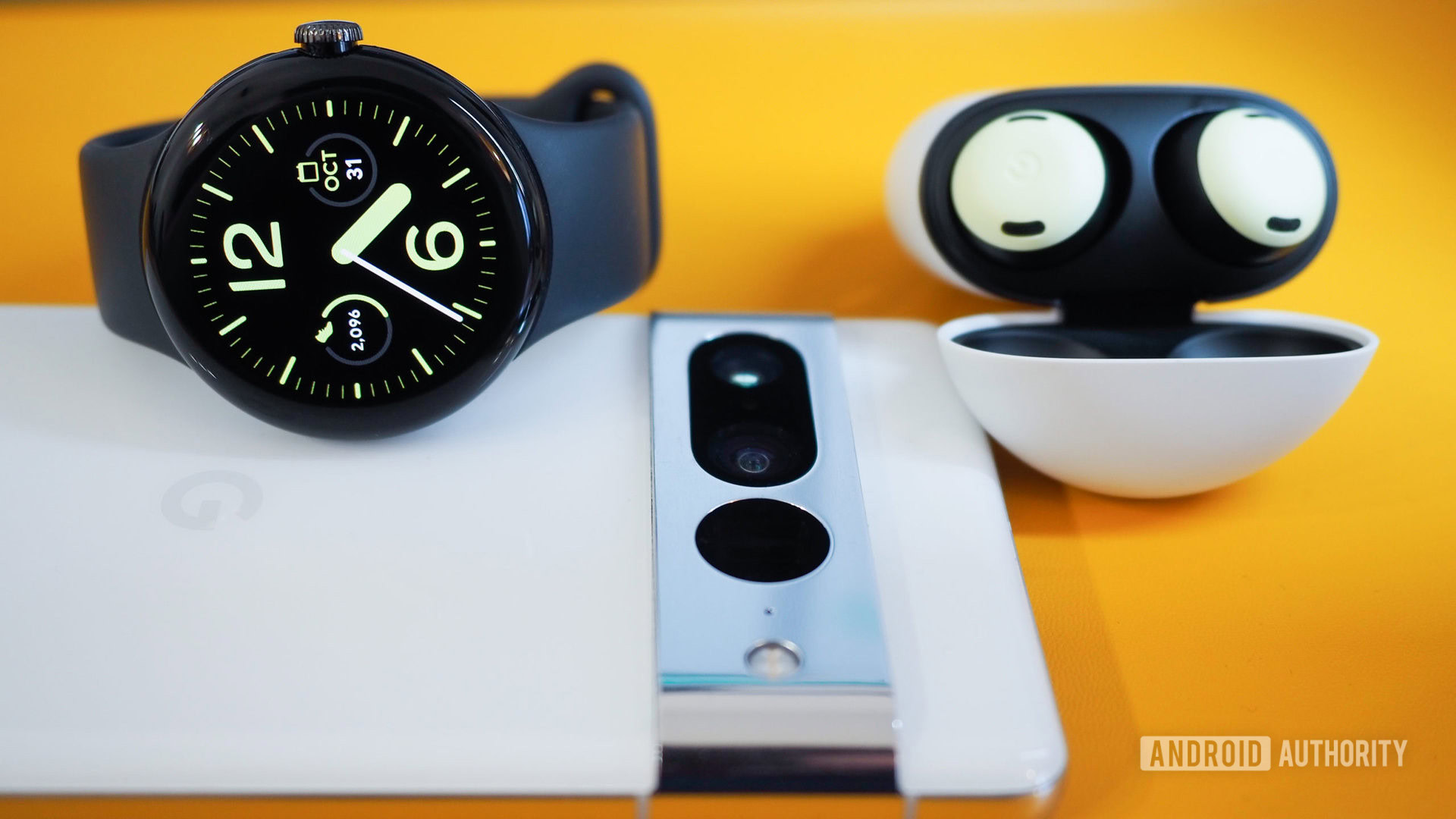
Samsung, Apple, Google, and OnePlus provide exclusive earbud features to their respective handsets. While getting a pair of earbuds tightly woven into your phone’s OS adds convenience and utility, it also locks you further into a given ecosystem. This may not seem like a big deal, but just because you’re a Google fan today, doesn’t mean you’ll feel the same way a year from now. That is why we include OS-agnostic picks like the Sony WF-1000XM5 and Beats Studio Buds Plus.
For those who insist on matching their earbuds to their phones, here’s a list of key features you usually gain access to:
- Automatic device switching (i.e. switching AirPods audio automatically when moving from an iPhone to an iPad and then to a Mac).
- Spatial audio with head tracking for compatible media.
- 24-bit audio playback.
- Location tracking for earbuds and the case.
- Hands-free voice access to the phone’s native smart assistant.
What is spatial audio, and do you need it?
Spatial audio is an advanced surround sound technology typically powered by Dolby Atmos. In a movie scene, a helicopter may fly above the main character, starting from the left side of the screen and exiting on the right. With spatial audio on, you’ll hear the height effect and panning of the helicopter sounds in your earbuds. Head tracking means that the earbuds communicate with your phone and adjust the audio while you move your head. This keeps you at the center of everything. While spatial audio has its place for movies and TV, the jury is still out on whether or not it adds to the music-listening experience.
Personalized spatial audio is a key feature that separates flagships from mid-tier products.
Pro tip: You don’t need specialty earbuds to take advantage of spatial audio. Apple Music, Amazon Music, and TIDAL enable spatial audio with any headphones. Buying a pair of earbuds that explicitly supports spatial audio usually means an app will personalize the sound based on your ear anatomy, or that it supports head tracking.
Does 24-bit audio matter?
While 24-bit audio is excellent for marketing, it doesn’t mean much for listening to music. Put simply, our brains can’t process the dynamic range of 24-bit, Hi-Res audio. Further, we can’t perceive the higher frequencies that lossless audio transmits. Audio engineers reap the greatest benefits of 24-bit audio files, as there is significantly more leeway for editing.
What are Bluetooth codecs?
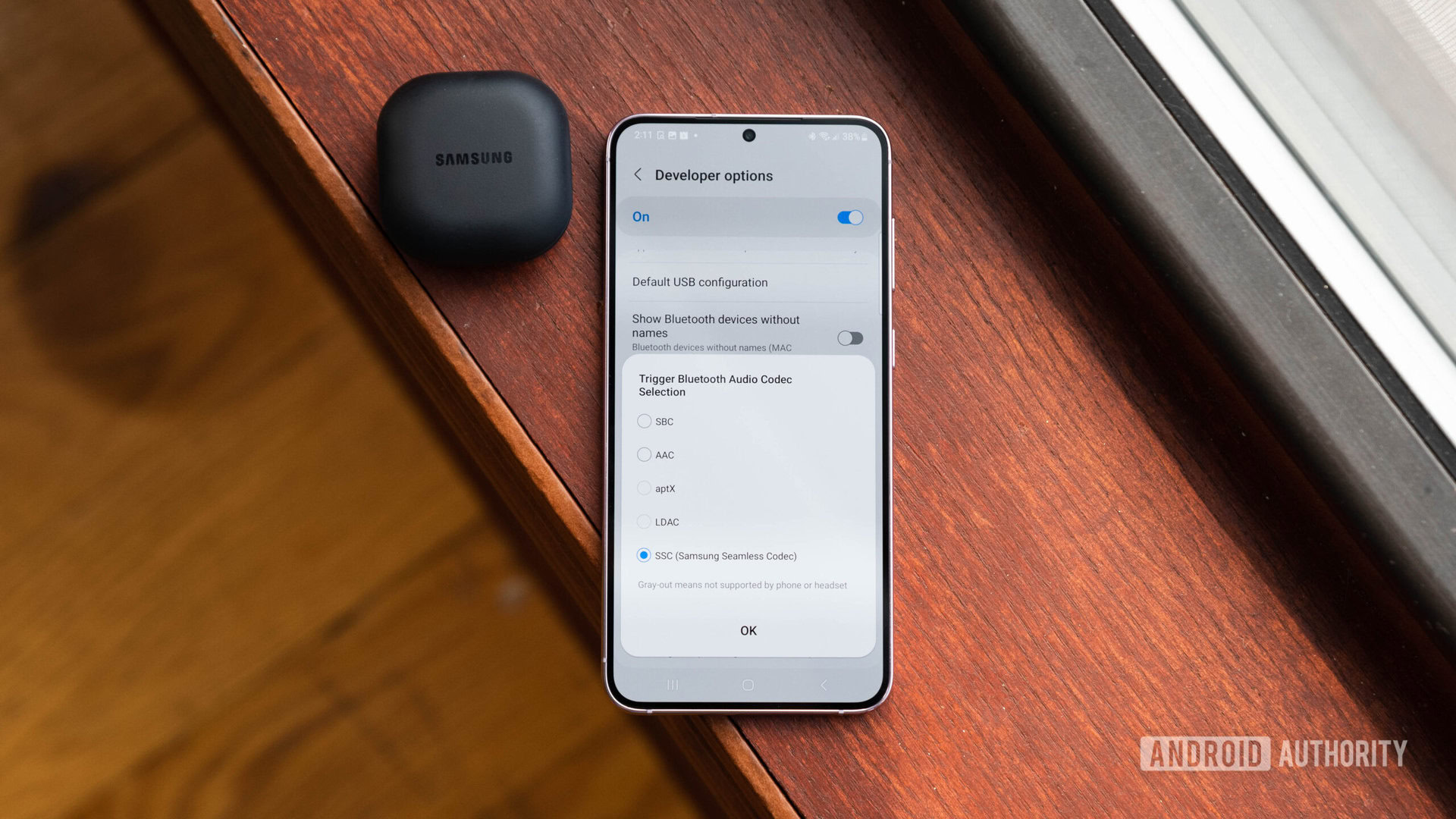
A Bluetooth codec determines how Bluetooth transmits audio data from your phone to your wireless earbuds, headphones, or speakers. This gets complicated. A good bit of guiding knowledge: AAC is the best Bluetooth audio codec for iPhones, and some form of aptX is best for Android phones. If you have a phone that supports a proprietary codec (e.g., Samsung Seamless Codec on the Galaxy S23,) you will get the best audio quality when paired with earbuds that support the Samsung Seamless Codec.
Latency problems arise with certain codecs and handsets. For example, AAC can cause noticeable audio-visual lag when streaming from certain Android phones. You may also encounter audio quality issues: LDAC is not technically Hi-Res.
How do you know if earbuds have good sound quality?
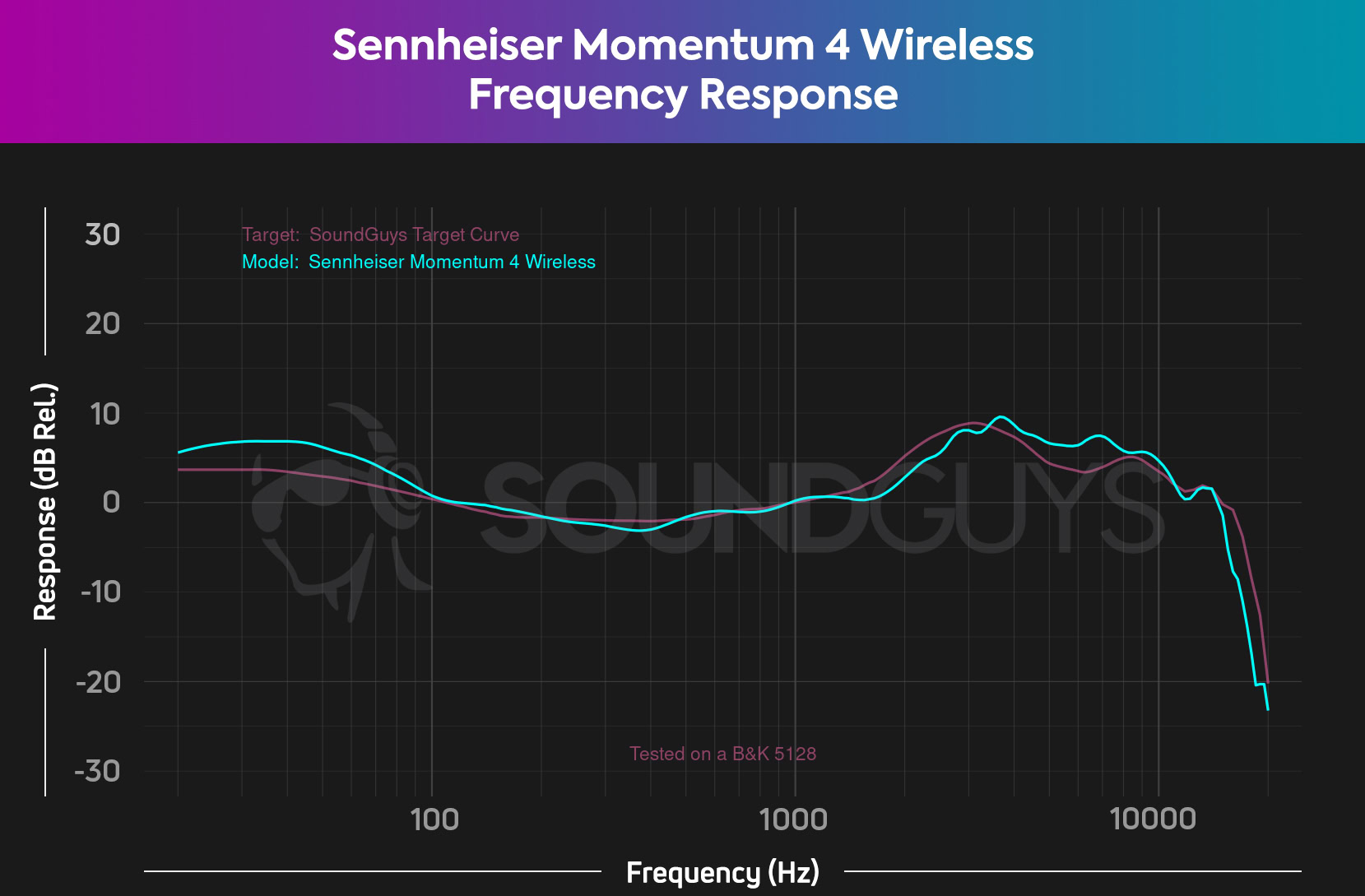
Whether or not earbuds sound good is entirely up to you. Generally, there are a few hallmarks of a “good” frequency response for consumer earbuds and headphones. Most earbuds have a frequency response with a light bass boost, relative to the mids, with notably louder treble. You’ll find this across the board. The frequency response will generally follow our sister site SoundGuys‘ headphone preference curve (pink trace).
How do you equalize the sound?
Many companion apps include custom EQ, but few teach you how to use it. For the best sound, reduce the volume of frequencies that are too loud rather than boost the frequencies that are too quiet. For earbuds that sound too bassy, reduce the bass before boosting the treble and mids. We recommend this method of equalizing because boosting quiet frequencies can add distortion.
Pay close attention to frequencies between 250-1,000Hz. This is where most instrument and vocal fundamental frequencies lie. If you start cutting this range and your music sounds too quiet or “hollow,” you may need to bring the loudness back up. You can do this with any third-party EQ app or custom EQ module in a proprietary app.
How do you know if earbuds fit well?
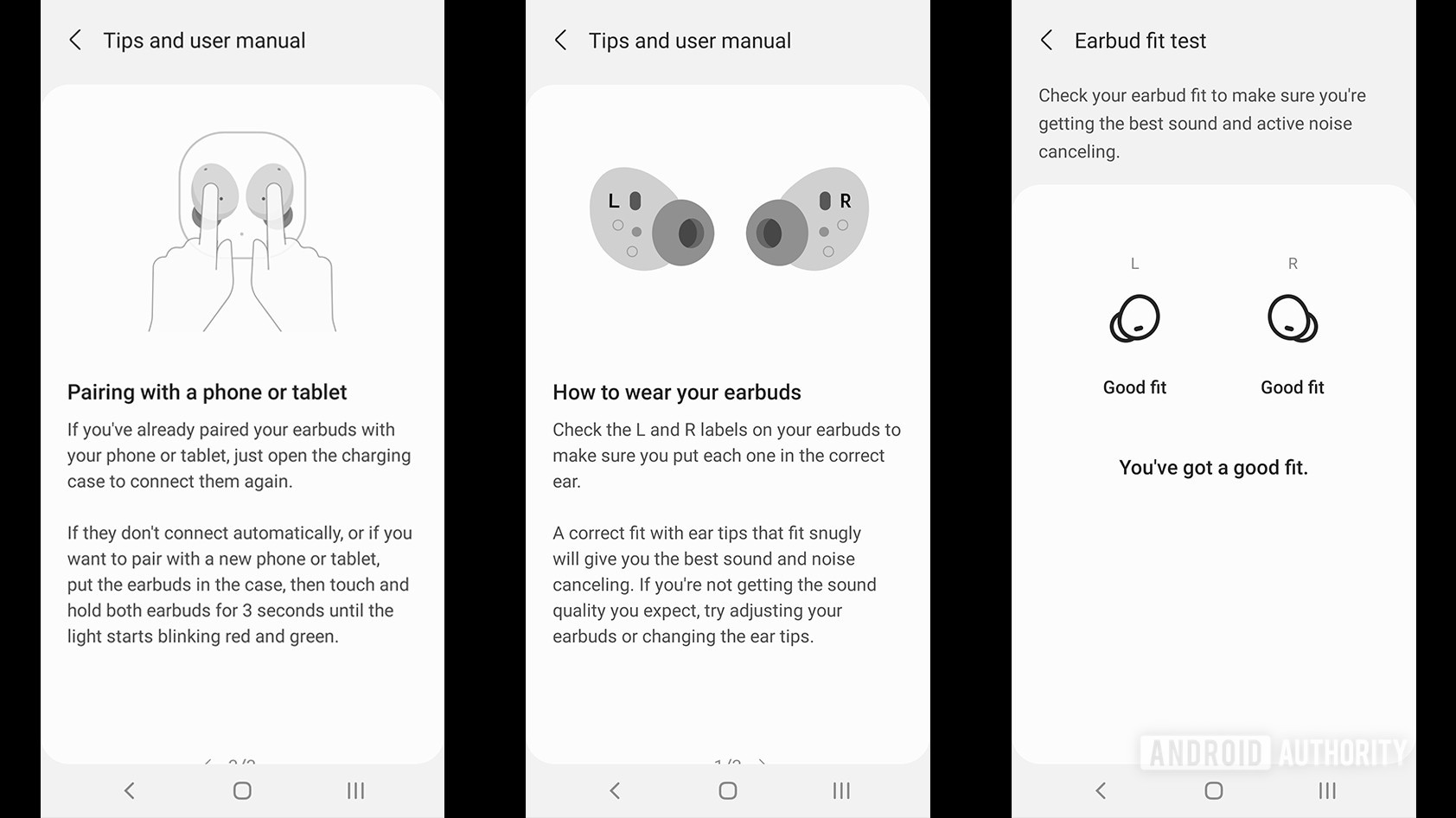
The simplest way to determine if your earbuds fit well is to use the guess-and-check method. Most earbuds come with three sets of ear tips, ranging from small to large. We recommend starting with the medium-sized ear tips and inserting the earbuds. Properly fitted ear tips will create a gentle seal where the tips meet your ear canals. Try wiggling your ears or jostling your head a bit. If the buds stay in place, they fit well.
Ear tips that are too small will cause the earbuds to fall right out of your ears when you shake your head. You will also still be able to hear a lot of background noise with ear tips that are too small. Ear tips that are too big will create uncomfortable pressure on your ear canals. These may also pop out with a head shake.
Another way to test if your earbuds fit well is to use an in-app ear tip fit test. Many apps offer a test. You often get an ear tip fit test when matching your earbuds to your phone. You can run an ear tip fit test with most Galaxy Buds and a Galaxy phone. It also works with most AirPods and an iPhone.
How long do earbuds last?
Some of our selections for the best wireless earbuds have nine-hour or higher battery life ratings, but earbud batteries generally last around five hours. Power-hungry features like noise canceling, spatial audio, and high-quality codec usage drain the battery faster. Earbuds house tiny lithium-ion cells that can’t compete with over-ear headphones.
If you’re not into the best wireless earbuds, here are the best headphones
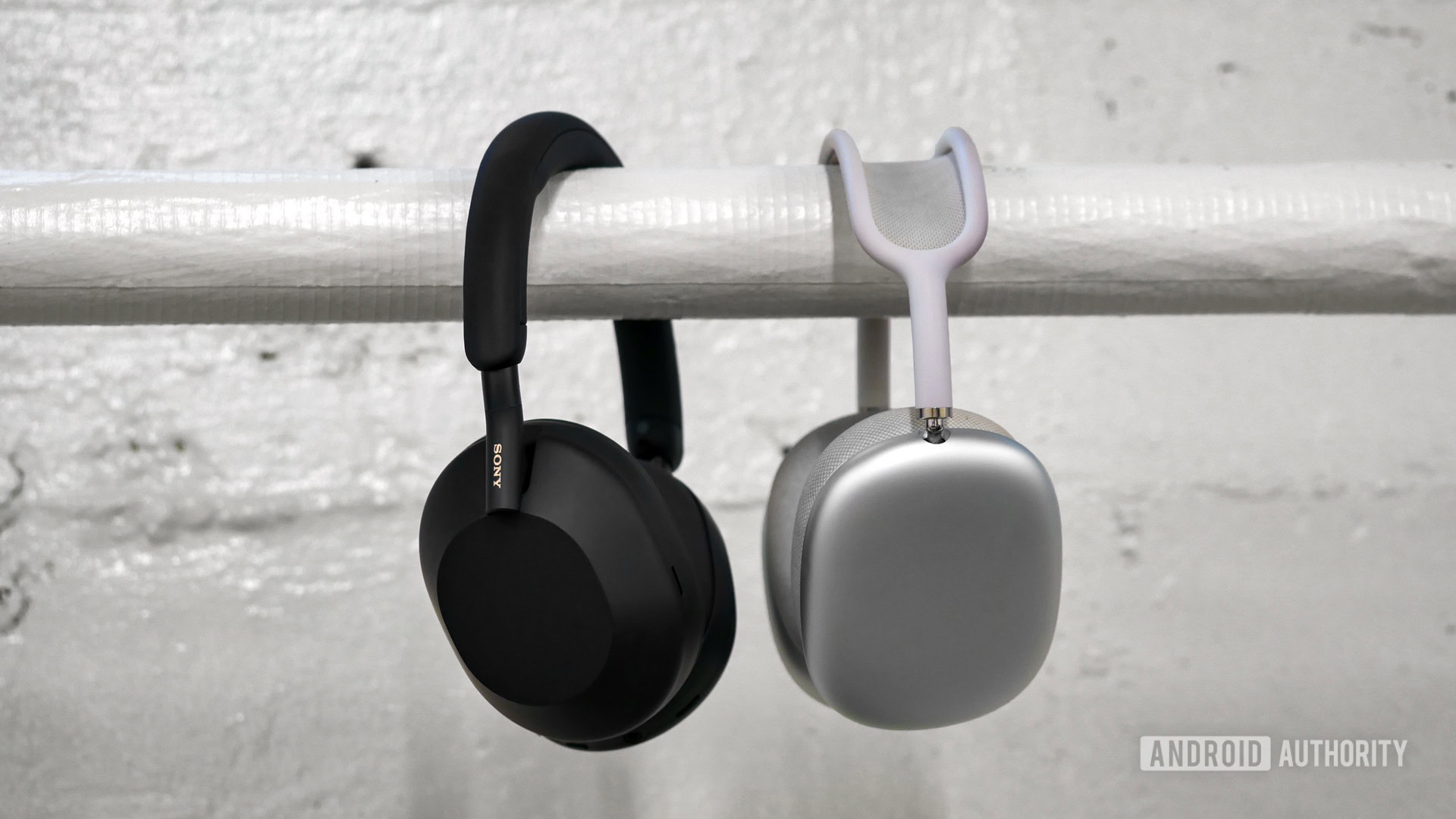
Even though this list covers the best earbuds you can buy, we know that not everyone likes how earbuds feel. If that resonates with you, take a look at some of our favorite headphones. All of our picks feature noise canceling, a comfortable fit, and good battery life.
- Sony WH-1000XM5 ($387 at Amazon): The Sony WH-1000XM5 noise canceling is top-notch. Like the WF-1000XM5, the headphones’ passive isolation impresses us. Sony’s bass-heavy sound may not please everyone, but it’s easy to EQ away through the Headphones Connect app. The battery lasts 31 hours and 53 minutes with ANC on, which is great given the demanding features. Unlike many other headphones, these support the SBC, AAC, and LDAC Bluetooth codecs for high-quality audio to any device. Microphone quality is stellar, especially when taking calls from loud environments. Whether you have an Android phone or an iPhone, the WH-1000XM5 are the best noise canceling headphones for any application.
- Apple AirPods Max ($399 at Amazon): Like the AirPods Pro (2nd generation), the AirPods Max work best with iPhones. The AirPods Max cancel out more low-frequency noise than Sony’s, so you’ll hear even less noise during your train commute or flight. When paired to an iPhone, you can enable Apple’s Spatial Audio with head tracking and access Siri with your voice. Switching between different Apple devices is as easy as locating the headphones through Apple’s Find My network. Like the earbud-style AirPods, the AirPods Max sound great by default. Bar none, the Apple AirPods Max are the best noise canceling headphones for iPhone owners.
- Bose QuietComfort Ultra ($429 at Amazon): Bose’s headphones feature a modern and lightweight design with a multifunction button for controlling audio playback. Unlike the Bose QuietComfort Headphones, the QuietComfort Ultra connect via a 2.5 to 3.5mm TRS cable or Bluetooth 5.3. Those sporting an Android phone with Qualcomm Snapdragon 888 or newer can use the high-res aptX Lossless Bluetooth codec. The headphones retain over 27 hours of constant music playback while topping up for 15 minutes rewards over two hours of charge. The large, comfortable, and dense earcups seal to the head well. Combined with the headphones’ ANC, low drones like bus engines and airplane whines have their loudness reduced by roughly 87%. If you can afford it, the Bose QuietComfort Ultra offer high-performing noise canceling that will stay relevant into the future.
- Sennheiser Momentum 4 Wireless ($289.23 at Amazon): These headphones have insane battery life and lasted 56 hours and 21 minutes in our testing — almost three times longer than average. When streaming over Bluetooth, you have your choice of five codecs: SBC, AAC, aptX, aptX HD, or aptX Adaptive. In typical Sennheiser style, the Momentum 4 Wireless sound great. To adjust the bass, mids, or treble, just download the Smart Control app (Android/iOS.) Like the Momentum True Wireless 3, you can even set certain sound presets based on your location. Anyone who wants great sound quality and good noise canceling should get the Momentum 4 Wireless.
Why you should trust us and how we test the best wireless earbuds
At Android Authority, we have a long history with tech devices. Along with our sister site, SoundGuys, we have tested hundreds of earbuds and headphones over the years. Our team of experts personally uses each product in their daily lives, at the gym, and on the go to see how they stack up in the real world. We select the best of these to make it onto our list of the best earbuds. We focus on user experience and sound quality, and to that end:
- We use the product for at least a week, listen to different music genres, and perform various activities.
- We note the comfort, construction quality, materials, and ease of use.
- We comb through any associated companion apps to ensure they work well with the earbuds.
- We make phone calls to check mic quality in the real world.
- We subject each earbud model to the same battery test, sound quality and frequency response tests, and isolation and ANC tests.
- We routinely go back and update old reviews when new features, fixes, or problems are discovered.
We’re thorough and don’t take this lightly! We recognize every model of earbuds is different. So, we determine what makes them unique (if anything) and how they stand out in the market. Then, we check to see if they might be missing anything important or have flaws that would knock them out of the running. Finally, we make objective measurements of everything we can. That includes battery life, frequency response, isolation, and noise canceling performance.
You can trust that our experts put each device through the wringer. We also revisit our reviews periodically to see how the products have held up over time.
Top wireless earbuds questions and answers
Based on our testing and that of our sister company, SoundGuys, we have made a list of the best wireless earbuds for 2024. In no particular order, these comprise the Sony WF-1000XM5 ($298 at Amazon,) Samsung Galaxy Buds 2 Pro ($179 at Amazon,) Google Pixel Buds Pro ($199 at Amazon,) Apple AirPods Pro (2nd generation) ($239 at Amazon,) and Jabra Elite 8 Active ($199 at Amazon.)
Due to people’s personal preferences, there is no official league table for what constitutes the best wireless earbuds. However, the Sony WF-1000XM5 ($298 at Amazon) earbuds are favored among Android and iOS smartphone owners alike. They deliver excellent sound quality with up to 50dB of noise canceling, in addition to eight hours of battery life and a list of high-end features. For these reasons, as well as their broad appeal, the Sony WF-1000XM5 could be considered the best true wireless earbuds.
While this is subjective, the Sony WF-1000XM5 are likely to have the broadest appeal among Android and iOS users alike.
Our top pick for 2024 are the Sony WF-1000XM5. However, picking the best earbuds is a subjective matter. If you own an iPhone and want seamless device integration, then the Apple AirPods Pro (2nd generation) will serve you best. Likewise, Samsung owners will enjoy the proprietary high-end features that the Galaxy Buds 2 Pro deliver.
Provided you plan on using the earbuds exclusively for conference calls in a quiet environment, the Apple AirPods Pro (2nd generation) ($239 at Amazon) have some of the best microphone arrays on the market. For a pair of earbuds that can intelligently reduce background noises such as office chatter and gusts of wind, the Anker Soundcore Liberty 4 NC ($99.99 at Amazon) will serve you better.
The best way to choose the most appropriate earbuds for you is to decide what features you value most. For example, if you intend to use your earbuds mostly for exercise, you should consider a pair of buds with a robust IP rating. However, if you desire superior audio quality, choosing a pair of earbuds that support AAC to match your iPhone or aptX for Android is a better choice. Ultimately, it all comes down to your personal preferences.
The Anker Soundcore Liberty 4 NC ($99.99 at Amazon) provide great noise canceling on a shoestring budget. Users also gain access to a ton of EQ settings in addition to Bluetooth 5.3 with LDAC support, an IPX4 water-resistance rating, Bluetooth Multipoint, and pleasing sound quality. The buds are a little heavy on the bass out of the box, but are great value for money and well worth considering.
The Samsung Galaxy Buds 2 Pro are the best Samsung earbuds for most people. However, if you want a more affordable option, we recommend the Galaxy Buds 2 ($99 at Amazon) or Galaxy Buds Live ($89 at Amazon). Both of these Galaxy Buds have noise canceling, but the Galaxy Buds Live are open earbuds. That means they don’t seal your ear canals off to the world. This works like the AirPods (3rd generation), but even Apple’s unsealed AirPods lack ANC.
If you are looking for a pair of earbuds that integrate well within the Samsung ecosystem, then look no further than the Samsung Galaxy Buds 2 Pro. In addition to superior ANC and sound quality, these buds boast the Samsung Seamless Codec to provide up to 512kbps, 24-bit/ 48kHz audio sampling. This feature is exclusive to Samsung smartphone owners.